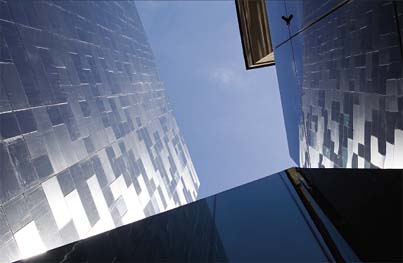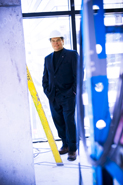Building to a crescendo
Taking a look at the Faculty of Music's finely tuned new facility

Photos by Claudio Calligaris

Schulich School of Music Dean Don McLean.
Almost unnoticed in the rush of spring exams and the forest of construction cranes, a sleek structure is rising at the corner of Sherbrooke and Aylmer. Dean Don McLean, in a cluttered office buried in the dusty halls of the Strathcona Music Building, enthusiastically describes the potential of the Faculty of Music's nearly complete building next door.
"It will be to music what a giant wind tunnel or a particle accelerator is to other research fields. Leading journals for sound recording production and for acoustical research are already recognizing the new centre as the go-to leader."
The project, conceived in 1994, evolved over the years into a facility spearheaded by McGill's Centre for Interdisciplinary Research in Music Media and Technology (CIRMMT). "Kermit," as it's familiarly known, attracts researchers from neuroscience, psychology, computer science and other disciplines to study everything from the perception of sound to recording to the creation of virtual reality.
The as-yet-unnamed extension to Strathcona will provide more space for the 600 undergraduates and more than 200 graduate students currently squeezed into space intended for 350. McLean notes that the expansion has already attracted interest from doctoral and postdoctoral students as well as visiting researchers.
Beyond that, the new facility will focus the attention of the world-wide music and film industries on Montreal. It will rival production centres in Los Angeles, New York and London, but unlike those facilities, it will couple production with advanced research. In this way, it will compare with labs already functioning at MIT, Stanford and in France.
"The centre will drive both content and technology, interacting with arts organizations in Montreal and abroad," McLean says. "Kent Nagano, the new Montreal Symphony Orchestra music director, can walk a block to the world's best recording facility. It certainly has commercial potential, though that's not a primary goal."
The addition of this new jewel will hardly harm the city's movie community. A large scoring stage can be used to produce film music and projects are already underway involving film and video students from the Université de Montréal, Université du Québec à Montréal and Concordia University.
Design was, fittingly, a well-orchestrated duet by two architectural firms, Menkes Shooner Dagenais and Saucier + Perrotte, with accompaniment by the likes of New York-based acoustics specialists from Artec and recording engineer Shawn Murphy, who has worked with such film luminaries as composer John Williams and producer-director Steven Spielberg. Lead architect Gilles Saucier created the building almost as a fine musical instrument.
"It's a precise machine, tuned to protect the interior environment from external sounds," Saucier observes. "Musical instruments are technically very advanced, and this building will permit very accurate sound production."
A double foundation surrounds the scoring stage topped by public areas and a 200-seat recital hall. The facade is covered in granite, stone, concrete and glass, but is particularly striking for its eight zinc-clad stories. When completed, the building will also contain an opera rehearsal room with sprung dance floor, sound recording control rooms, research labs for music technology and acoustics, seminar rooms and the Marvin Duchow Music Library.
The official opening is scheduled for September 30, though the library is moving in now and will open in July. Completion of staff and administrative offices and the full outfitting of the recording facilities are still on hold until more support can be found. Fuelled by major grants from the Quebec Ministry of Education, Recherche Québec, and Canada Foundation for Innovation, the $50 million base building — $70 million when fully equipped — would have been beyond the wildest dreams of Donald Smith (Lord Strathcona), who gave the original building to McGill as a women's residence (known to young men of an earlier generation as Fort Knox). The faculty, founded as the McGill Conservatorium of Music in 1904 in part to provide young ladies with an appropriate education, has grown over a century to become Canada's largest and finest university-based music school, renowned for its orchestral, choral, opera, jazz, chamber and early music programs. It has produced award-winning creative and research work in composition, theory, musicology, music education, sound recording and music technology.







